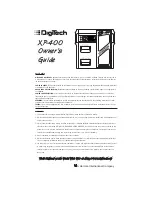
818
Appendix A: Functions and Instructions
nCr()
MATH/Probability menu
nCr(
expression1
,
expression2
)
⇒
expression
For integer
expression1
and
expression2
with
expression1
‚
expression2
‚
0,
nCr()
is the number of
combinations of
expression1
things taken
expression2
at a time. (This is also known as a binomial
coefficient.) Both arguments can be integers or
symbolic expressions.
nCr(
expression, 0
)
⇒
1
nCr(
expression, negInteger
)
⇒
0
nCr(
expression, posInteger
)
⇒
expression
ø
(
expression
ì
1)
... (expression
ì
pos1)/
posInteger!
nCr(
expression, nonInteger
)
⇒
expression!/
((
expression
ì
nonInteger)!
ø
nonInteger!)
nCr(z,3)
z
ø
(z
ì
2)
ø
(z
ì
1)
6
ans(1)|z=5
10
nCr(z,c)
z!
c!(z
ì
c)!
ans(1)/nPr(z,c)
1
c!
nCr(
list1
,
list2
)
⇒
list
Returns a list of combinations based on the
corresponding element pairs in the two lists. The
arguments must be the same size list.
nCr({5,4,3},{2,4,2})
¸
{10 1 3}
nCr(
matrix1
,
matrix2
)
⇒
matrix
Returns a matrix of combinations based on the
corresponding element pairs in the two matrices.
The arguments must be the same size matrix.
nCr([6,5;4,3],[2,2;2,2])
¸
[
15 10
6 3
]
nDeriv()
MATH/Calculus menu
nDeriv(
expression1
,
var[
,
h]
)
⇒
expression
nDeriv(
expression1
,
var, list
)
⇒
list
nDeriv(
list
,
var[
,
h]
)
⇒
list
nDeriv(
matrix
,
var[
,
h]
)
⇒
matrix
Returns the numerical derivative as an expression.
Uses the central difference quotient formula.
h
is the step value. If
h
is omitted, it defaults to
0.001.
When using
list or matrix, the operation gets
mapped across the values in the list or across the
matrix elements.
Note:
See also
avgRC()
and
d
()
.
nDeriv(cos(x),x,h)
¸
ë
(cos(x
ì
h)
ì
cos(x+h))
2
ø
h
limit(nDeriv(cos(x),x,h),h,0)
¸
ë
sin(x)
nDeriv(x^3,x,0.01)
¸
3.
ø
(x
ñ
+.000033)
nDeriv(cos(x),x)|x=
p
/2
¸
ë
1.
nDeriv(x^2,x,{.01,.1})
¸
{ 2 .
ø
x 2 .
ø
x }
NewData
CATALOG
NewData
dataVar
,
list1
[
,
list2
] [
,
list3
]
...
Creates data variable
dataVar,
where the columns
are the lists in order.
Must have at least one list.
list1
,
list2
, ...,
listn
can be lists as shown, expressions
that resolve to lists, or list variable names.
NewData
makes the new variable current in the
Data/Matrix Editor.
NewData mydata,{1,2,3},{4,5,6}
¸
Done
(Go to the Data/Matrix Editor and open the
var
mydata
to display the data variable below.)
NewData
dataVar
,
matrix
Creates data variable
dataVar
based on
matrix
.
Summary of Contents for Titanium TI-89
Page 9: ...Getting Started 6 TI 89 Titanium keys Ë Ì Í Ê ...
Page 34: ...Getting Started 31 2 or D 2 B u s i n e s s D B D B Press Result ...
Page 43: ...Getting Started 40 3 0 D B D D B D Press Result ...
Page 44: ...Getting Started 41 D 2 0 0 2 D B Scroll down to October and press Press Result ...
Page 58: ...Getting Started 55 Example Set split screen mode to TOP BOTTOM Press Result 3 B D ...
Page 70: ...Getting Started 67 ...
Page 175: ...Operating the Calculator 172 From the Keyboard ...
Page 456: ...Tables 453 ...
Page 527: ...Data Matrix Editor 524 ...










































